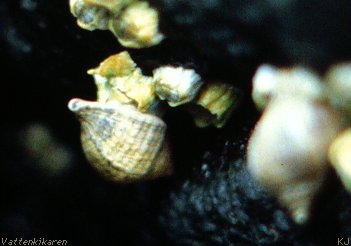|

|
|

A
dogwhelk eating a barnacle.
Really small barnacles run the risk of
being eaten by e.g. rough
periwinkles and common
periwinkles. Algae, waving back and forth in the waves also pose a
threat by wearing on the foundation upon which the barnacle sits. Algae
can also cover
possible sites upon which the barnacle might attach itself.
Onchidoris bilamellata and the green leaf worm Eulalia
viridis also eat barnacles, aswell as some fish e.g. ballen
wrasse .
The Northern rock barnacle tolerates the cold very well,
but ice
is a real threat. Wave action upon the ice can cause a grinding effect
which scapes away barnacles living close to the mean
water level. First, during the spring, when the larvae have attached
themselves to the rocks and grown a little, you are able to see the white
belts along the cliffs again.
|

|
Page
6 of 7
|

|
|

![]()
